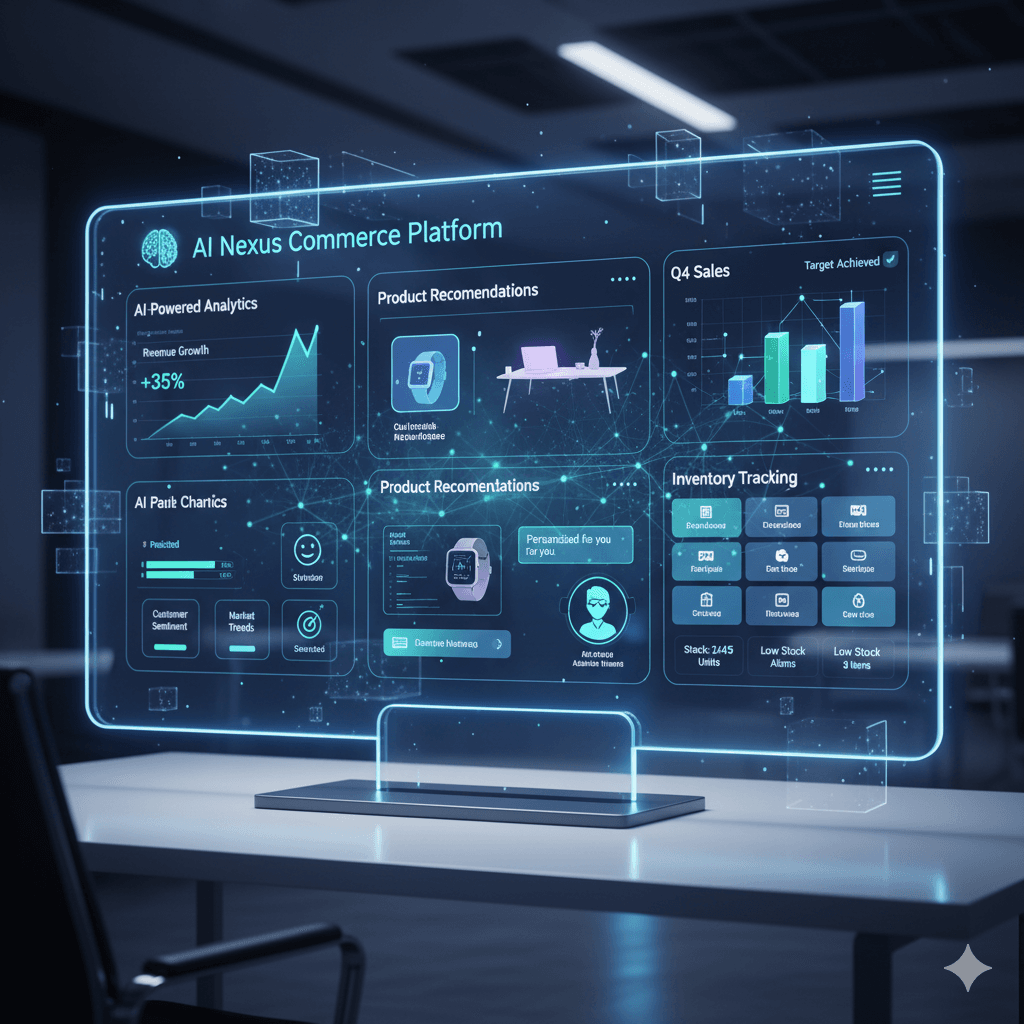AI in Online Shopping: Honors Every Unique Body Type
AI in E-commerce Business: Use Cases, Benefits & Future


TL;DR
AI is transforming the ecommerce industry by making shopping smarter, faster, and more personalized. From recommendation engines, chatbots, dynamic pricing, and inventory optimization to visual and voice search, AI helps businesses boost sales, reduce costs, and improve customer experience. Tools like Glance AI enable virtual try-ons, trend forecasting, and style personalization. While AI automates repetitive tasks, human creativity remains essential.
In 2010, ecommerce was about putting things in a cart. In 2025, it’s about context, prediction, and personalization. The ecommerce game has fundamentally changed, and AI is the silent engine driving this transformation.
According to Precedence Research, the global AI in the ecommerce market is projected to touch a staggering $45.7 billion by 2030. That's not just a growth story—it's a complete reshaping of how we buy, sell, and interact online. Add to that Epsilon's report stating 88% of online shoppers are more likely to purchase from brands offering personalized experiences, and it's clear: AI isn't just the future; it's the new standard.
In this guide, we’re diving deep into how AI in ecommerce business is powering the ecommerce revolution. You’ll discover use cases, real-world stats, best practices, and a future-forward outlook that will help you stay ahead of the curve.
What Is AI in Ecommerce Business?

At its core, AI in the e-commerce industry refers to the use of machine learning, natural language processing, and predictive algorithms to mimic human decision-making and personalize user experience at scale.
Think of it this way: traditional ecommerce reacts. AI-powered ecommerce anticipates.
By 2025, Gartner projects that at least 30% of digital businesses will use AI to improve customer experience. From personalized recommendations to voice search and dynamic pricing, AI is no longer a nice-to-have. It’s fundamental.
Types of Ecommerce Technologies Powering Business

Modern ecommerce relies on a sophisticated mix of AI and related technologies to streamline operations and enhance the shopping experience. Here’s a breakdown of the critical tech powering today’s digital storefronts:
1. Natural Language Processing (NLP) & Conversational AI
Ecommerce platforms use NLP-powered chatbots and voice assistants to handle customer queries, guide shoppers, and assist at checkout—all in real time. These AI agents can reduce handling time by 9% and resolve 14% more tickets, significantly lowering support costs.
2. Machine Learning (ML) & Predictive Analytics
ML is at the heart of demand forecasting, inventory optimization, customer segmentation, and fraud detection. Shopify reports that 44% of retailers use AI for demand prediction and 41% for segmentation shopify.com. Predictive pricing algorithms also dynamically adjust prices to balance demand, inventory levels, and competition—boosting profitability.
3. Computer Vision & Visual Commerce
Visual search and product tagging use computer vision to detect what shoppers show interest in via images—so they can instantly find similar styles. Retailers also use image-based systems to flag damaged goods and improve catalog quality.
4. Generative AI & Content Automation
Generative AI in ecommerce business powers everything from product descriptions to marketing visuals. Platforms like DALL·E enables merchants to generate custom images for campaigns without hiring designers.
5. Behavioral Triggers & On‑Site Engagement
Tools such as Wisepops use AI in ecommerce business to serve pop-ups and offers based on shopper behavior—reducing exits and increasing conversions .
6. Security & Fraud Detection
AI systems analyze patterns and transaction data to spot anomalies like sudden high-value purchases or unfamiliar locations—preventing fraud before it occurs.
7. Integrated Checkout & Smart POS
AI-enabled POS systems offer intelligent product recommendations, inventory tracking, and unified payments for both online and in-store shoppers
Key Use Cases of AI in Ecommerce Business (With Real-World Examples)

Let’s break down exactly where AI in ecommerce business is showing up and reshaping the way ecommerce businesses operate.
A. Personalized Recommendations
Amazon’s product recommendation engine drives 35% of its total revenue. And that’s just the beginning. AI algorithms analyze browsing history, purchase behavior, location, and even time of day to serve up the perfect product suggestion.
B. AI-Powered Customer Support (Chatbots & NLP)
AI chatbots now handle everything from order status to complex returns. IBM reports that AI can cut customer support costs by up to 30%.
Shopify’s AI assistant, Kit, helps merchants write Facebook ads, suggest products, and even manage campaigns—all via chat.
C. Dynamic Pricing & Demand Forecasting
AI in ecommerce business helps the platforms adjust prices in real-time based on demand, competition, and inventory. McKinsey found that retailers using AI for pricing optimization saw a 2-5% increase in margins.
D. Visual & Voice Search
Visual search allows users to upload an image and get similar product suggestions. Voice search is booming too, especially with Gen Z consumers. HubSpot states that 62% of Gen Z prefers visual search over text.
E. Generative AI for Content Creation
From product descriptions to landing page copy, generative AI is cutting creative production time by half. According to BCG, brands using Gen AI tools see up to 40% reduction in content creation costs.
F. Inventory Optimization
Capgemini research shows that AI-driven inventory management can reduce stockouts by up to 30%. It predicts demand, aligns supply, and helps businesses avoid both overstocking and lost sales.
Benefits of Using AI in Ecommerce Business
1. Hyper-Personalization at Scale
AI enables retailers to offer every user a curated shopping experience. Using behavioral data, search patterns, and even social media activity, AI generates product suggestions that feel tailor-made — not just based on what users like, but what they might like next.
Did you know? McKinsey reports that personalization can drive a 10–15% revenue uplift in eCommerce.
2. Intelligent Search and Discovery
With AI-powered semantic search (like Algolia or Shopify's AI search), consumers no longer have to type perfect keywords. Instead, the system understands intent — even if queries are vague or misspelled.
For example: Searching for “comfy work-from-home shoes” yields results aligned with comfort, style, and use case — not just brand or category.
3. Dynamic Pricing and Inventory Management
AI models predict demand spikes, competitor pricing shifts, and supply chain constraints. This allows businesses to automatically adjust prices for higher conversions and profit margins, while also minimizing stockouts or overstock issues.
4. Conversational AI & 24/7 Support
AI chatbots like ChatGPT or ElevenLabs offer real-time, context-aware support. They reduce support ticket volumes by 40–60%, resolve common issues quickly, and improve CSAT scores — especially outside working hours.
5. Fraud Detection and Security
AI’s pattern recognition is unmatched in detecting anomalies — from suspicious login attempts to unusual checkout behavior. This safeguards both the merchant and consumer from evolving cyber threats.
According to PwC, AI adopters in retail saw a 25% average increase in customer satisfaction, and the World Economic Forum highlights $70B saved annually in supply chain planning alone.
Challenges & Barriers in Adoption of AI in Ecommerce Business

1. Data Dependency and Quality Issues
AI thrives on data. But poor data hygiene, siloed systems, or inconsistent labeling can skew outcomes — leading to irrelevant recommendations or flawed automation.
2. Integration with Legacy Systems
Many traditional eCommerce platforms aren’t designed with AI in mind. Integrating AI tools with ERP systems, POS data, or outdated CMS platforms can delay rollouts and require costly middleware solutions.
3. Cost and Resource Constraints
Deploying generative AI — especially with custom models — can be expensive. From hiring skilled data scientists to paying for computer infrastructure, the costs can be prohibitive for SMBs without clear ROI projections.
4. Talent Gap in AI and ML
There's a global shortage of skilled professionals in AI, ML, and data science. Even if tools are available, lack of in-house expertise can prevent proper implementation and long-term optimization.
Only 26% of small ecommerce businesses use AI (Statista). Also, Cisco reports that 65% of consumers are concerned about how their data is used in AI-based personalization.
How is Glance AI Transforming Ecommerce Business Globally?
Leveraging AI for personalized shopping, virtual try-ons, and predictive trend analysis, Glance is redefining the fashion industry. Glance AI app offers:
- Personalized Recommendations: Using AI, Glance understands your style preferences, making sure every product suggestion feels like it was handpicked for you.
- AI Styling: With Gen AI, the app allows you to visualize outfits on your own digital avatar, removing the guesswork and reducing returns.
- Predictive Trend Analysis: By analyzing global fashion data, Glance can forecast emerging styles, ensuring you’re always ahead of the curve.
So you can stay ahead of the fashion industry.
What is the Future of AI in E-commerce?
So, what’s next? As AI continues to mature, you can expect:
Deeper Personalization:
Beyond just style recommendations, AI might tailor entire lookbooks based on your past purchases, social media activity, or even local weather.
Immersive AR/VR Stores:
Imagine browsing a virtual store where you walk through digital aisles, pick up items, and try them on in a 3D environment—no real-world store needed.
Sustainability Analytics:
AI could analyze every stage of a product’s lifecycle to ensure ethical sourcing, minimal waste, and carbon footprint reduction.
Real-Time Inventory and Pricing:
Dynamic pricing and stock management could become even more precise, ensuring you always find what you need, right when you need it.
Voice Commerce:
With advancements in natural language processing, you might soon ask your voice assistant to “show me a red jacket for under $100” and get instant, curated results.
Forrester predicts that 80% of consumer-brand interactions will be AI-powered by 2030, and Accenture adds that 1 in 4 retail decisions will be made with minimal human input.
Conclusion
AI in the ecommerce industry isn’t about replacing humans. It’s about elevating the entire buying journey. From predicting needs before they’re expressed to personalizing content at scale, AI is helping businesses create more intelligent, more intuitive, and more delightful shopping experiences.
As we move toward a hybrid future where AI and human creativity coexist, the message is clear: Brands that embrace AI today won't just survive—they'll lead.
FAQs
1. What is AI in eCommerce?
AI in eCommerce refers to technologies that help online stores deliver smarter, more personalized shopping experiences. It powers product recommendations, automates customer support, optimizes inventory and pricing, enhances search with visual or voice tools, and detects fraud. By analyzing data and automating routine tasks, AI improves efficiency, boosts sales, and helps businesses create seamless, tailored experiences for every shopper.
2. How is AI used in eCommerce today?
Today, AI in eCommerce is widely used to enhance both customer experience and business efficiency. It powers recommendation engines, chatbots, visual and voice search, dynamic pricing, and sentiment analysis. AI also helps prevent fraud, optimize inventory, and analyze customer behavior, enabling retailers to offer personalized, seamless shopping experiences while improving operational decision-making.
3. How is AI used in the fashion industry?
AI is widely used in the fashion industry to enhance design, production, and customer experiences. It powers virtual try-ons, predicts trends through advanced forecasting, and provides personalized styling recommendations. AI also optimizes supply chains, improves inventory planning, and helps reduce overproduction, allowing brands to respond faster to changing consumer preferences while minimizing waste.
4. How is AI used in eCommerce?
AI is used in eCommerce to make online shopping smarter and more personalized. It powers recommendation engines, enhances search with visual and voice tools, automates customer support, and helps retailers optimize inventory and pricing. AI also detects fraud, analyzes customer behavior, and generates marketing content, enabling businesses to improve efficiency, boost sales, and deliver seamless shopping experiences.
5. What is the future of AI in the eCommerce industry?
The future of AI in eCommerce will see it become the backbone of smart commerce. AI will enable predictive demand planning, hyper-local personalized recommendations, and immersive shopping experiences through AR and VR. Advanced conversational agents and autonomous systems will streamline operations, optimize logistics, and create seamless, intuitive interactions, helping retailers boost efficiency, engagement, and sales.
6. Will AI replace human roles in eCommerce?
No, AI is not expected to fully replace human roles in eCommerce. Instead, it will transform how people work by automating repetitive tasks and enhancing human capabilities. This allows employees to focus on creative, strategic, and customer-focused activities that require judgment, empathy, and problem-solving. Successful adoption depends on humans collaborating with AI and developing both technical and interpersonal skills.
7. Is AI affordable for small eCommerce businesses?
Yes, AI is increasingly affordable for small eCommerce businesses. Many plug-and-play tools enable customer service chatbots, automated product descriptions, personalized marketing, and inventory insights. These solutions integrate easily with platforms like Shopify and other eCommerce software, allowing small businesses to save time, boost sales, and compete effectively without needing a large budget or technical expertise.







